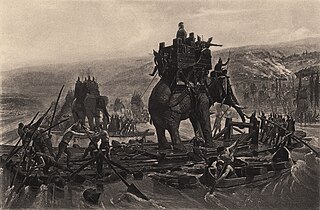
The 3rd century BC started the first day of 300 BC and ended the last day of 201 BC. It is considered part of the Classical Era, epoch, or historical period.
This article concerns the period 229 BC – 220 BC.

This article concerns the 200 BC decade, that lasted from 209 BC to 200 BC.
This article concerns the period 279 BC – 270 BC.
This article concerns the period 269 BC – 260 BC.
This article concerns the period 259 BC – 250 BC.
This article concerns the period 249 BC – 240 BC.
This article concerns the period 219 BC – 210 BC.
This article concerns the period 199 BC – 190 BC.
Year 210 BC was a year of the pre-Julian Roman calendar. At the time it was known as the Year of the Consulship of Marcellus and Laevinus. The denomination 210 BC for this year has been used since the early medieval period, when the Anno Domini calendar era became the prevalent method in Europe for naming years.
Year 212 BC was a year of the pre-Julian Roman calendar. At the time it was known as the Year of the Consulship of Flaccus and Pulcher. The denomination 212 BC for this year has been used since the early medieval period, when the Anno Domini calendar era became the prevalent method in Europe for naming years.

Year 220 BC was a year of the pre-Julian Roman calendar. At the time it was known as the Year of the Consulship of Laevinus/Catulus and Scaevola/Philo. The denomination 220 BC for this year has been used since the early medieval period, when the Anno Domini calendar era became the prevalent method in Europe for naming years.
Year 215 BC was a year of the pre-Julian Roman calendar. At the time it was known as the Year of the Consulship of Albinus/Marcellus/Verrucosus and Gracchus. The denomination 215 BC for this year has been used since the early medieval period, when the Anno Domini calendar era became the prevalent method in Europe for naming years.
Year 227 BC was a year of the pre-Julian Roman calendar. At the time it was known as the Year of the Consulship of Flaccus and Regulus. The denomination 227 BC for this year has been used since the early medieval period, when the Anno Domini calendar era became the prevalent method in Europe for naming years.
Gnaeus Cornelius Scipio Calvus was a Roman general and statesman during the third century BC. He played a major part in the Second Punic War, establishing Roman rule in the east of the Iberian peninsula and tying up several Carthaginian armies to keep them from reinforcing Hannibal.
Achaeus was a general and later a separatist ruler of part of the Greek Seleucid kingdom. He was the son of Andromachus, whose sister Laodice II married Seleucus II Callinicus, the father of Antiochus III the Great. He accompanied Seleucus III Ceraunus, the son of Callinicus, in his expedition across mount Taurus against Attalus I, and after the assassination of Seleucus III Ceraunus revenged his death; and though he might easily have assumed the royal power right then, he remained faithful to Antiochus III, brother of Seleucus III, for the time being, that is until he proclaimed himself king in 220 BC.
The Battle of Clastidium was fought in 222 BC between a Roman army led by the consul Marcus Claudius Marcellus and the Insubres, a Celtic people in northern Italy. Florus writes that the Insubres were led by Viridomarus, or Britomartus, as the name varies in translation. The Romans won the battle, and in the process, Marcellus earned the spolia opima, one of the highest honors in ancient Rome, by killing the king in single combat. It was also notable as one of the few battles won by the Roman cavalry without any aid by the legions.
Viridomarus was a Gallic military leader of the Gaesatae. In 222 BC he was hired by the Insubres who were fighting the Romans. Viridomarus led an mercenary army against a Roman army at the Battle of Clastidium. The Romans won the battle, and in the process, Marcus Claudius Marcellus, the Roman leader, earned the spolia opima by killing Viridomarus in single combat.

The Insubres or Insubri were an ancient Celtic population settled in Insubria, in what is now the Italian region of Lombardy. They were the founders of Mediolanum (Milan). Though completely Gaulish at the time of Roman conquest, they were the result of the fusion of pre-existing Ligurian and Celtic population with Gaulish tribes.
Acerrae was a city of Cisalpine Gaul, in the territory of the Insubres. Polybius describes it merely as situated between the Alps and the Po; and his words are copied by Stephanus of Byzantium: but Strabo tells us that it was near Cremona: and the Tabula places it on the road from that city to Laus Pompeia, at a distance of 22 Roman miles from the latter place, and 13 from Cremona. These distances coincide with the position of Gherra or Gera, a village, or rather suburb of Pizzighettone, on the right bank of the river Adda. It appears to have been a place of considerable strength and importance even before the Roman conquest: and in 222 BC, held out for a considerable time against the consuls Marcellus and Scipio, but was compelled to surrender after the Battle of Clastidium.



